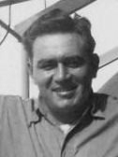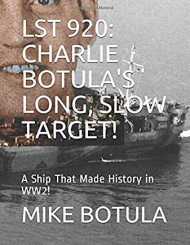In the Spotlight! MikeBo's Top Stories
From History's Headlines! Harry Schultz: Defiant Hero!
Sunday December 7, 1941
The Harry Schultz Story
By Mike Botula
Sunday Morning December 7, 1941 was a perfect day in a Pacific Island paradise.....until about 8 o'clock that morning! Then the world changed forever and the next day President Franklin Delano Roosevelt would call it “A Day That Will Live in Infamy” as the Congress of the United States declared that a state of war existed between the United States and the Empire of Japan. World War Two, for the United States, had begun.
In their all-out attack on the U.S. Pacific Fleet, the key targets for the Japanese were the battleships. They sank Arizona, California, Oklahoma, and West Virginia. USS Arizona still rests on the bottom, a war grave with more than a thousand valiant souls still aboard. In the midst of all of this flame and carnage, one scrappy destroyer escaped to fight another day, and took her fair measure of vengeance on the attackers. She was the destroyer USS Jarvis (DD 393) and on board was a young Quartermaster named Harry Neil Schultz who would one day follow the lead of his ship’s namesake and disobey a direct order during the heat of battle to become one of the true heroes of World War II.
Lest the Jarvis namesake be completely lost to history, let me introduce you to Midshipman James C. Jarvis (1787-1800). Three U.S. Destroyers have carried his name into battle: Jarvis I DD 38 which saw combat in World War I, Jarvis II DD 393, which escaped the Pearl Harbor attack, and Jarvis III, DD 799, which saw service from the end of World War 2 through the Vietnam War before it was decommissioned and given to the Spanish Navy. Midshipman Jarvis was born in 1787 and appointed as a Midshipman from the State of New York in 1799. As was the custom of the day, Midshipman Jarvis went to sea aboard the famed frigate Constellation. During its battle with the French frigate La Vengeance Deux in February 1800 young Jarvis was sent aloft to secure the ship’s mainmast. At one point he was ordered down for fear the mast might topple. He yelled down, “My post is here. I can’t leave it.” The mast crashed down and Jarvis went over the side with the rigging and was drowned. He was 13 years old.
On the Sunday morning of December 7, 1941, the second destroyer Jarvis was moored
next to another destroyer, the USS Mugford - DD 389, and their tender, USS Sacramento, a converted 1914 vintage gun boat. The “after action” reports of all three ships show the Japanese attack beginning at 0758 on that Sunday morning. General Quarters was immediately sounded and all three destroyers opened fire on the attacking aircraft with anti-aircraft machine guns and their five inch guns. The ship’s log notes that the machine guns commenced firing at 0804 hrs, with the five inch gun firing the first shot of any five inch gun in the harbor 60 seconds later. The USS Jarvis was credited with shooting down four enemy aircraft during its escape from Ford Island to the open sea. It is believed that Jarvis was the first to draw enemy blood on that bloody Sunday. Among the seamen receiving special commendation for their action during the attack was Quartermaster First Class Harry Niel Schultz, who had been with the Jarvis since it was commissioned in 1937.
Schultz was later given a commission and eventually commanded the LST that my dad sailed on in WW2. But, on December 7th, Schultz, a career peacetime Navy enlisted man, was aboard the Jarvis. The Jarvis fought its way to the open sea and safety. Its gunners shot down four enemy warplanes and evaded the attackers’ efforts to sink it and block the harbor entrance.
Schultz and the Jarvis survived Pearl Harbor, and about two weeks later Jarvis left Pearl Harbor with the carrier Saratoga to join the Task Force assigned to relieve the Japanese attack on Wake Island, but, in a controversy that resounds to this day, that mission was scuttled and the Japanese took the island on December 23rd. In January 1942, while on an anti-submarine patrol the Jarvis rescued 182 survivors of a Japanese torpedo attack on the fleet oiler Neces. By July, 1942, Schultz and the Jarvis were on their way to the Solomon Islands to take part in the invasion of Guadalcanal on August 7th. The transport ships that Jarvis was escorting came under a heavy attack and the destroyer was torpedoed in spite of the fact that only 9 of the 26 attacking Japanese planes were able to penetrate the American defenses. After the battle the ship moved to Tulagi where seven wounded crewmen were transferred to a hospital on shore. Quartermaster Harry Schultz went ashore with them to make sure they were cared for. That assignment saved his life.
The Jarvis’ skipper, Lt. Comdr. William Graham, Jr. ordered the ship to steam for Sydney Australia for repairs, unwittingly ordering his ship into the maelstrom known as the bloody “Battle of Savo Island.” Shortly after, she steamed across “Iron Bottom Sound” and ran into the approaching fleet of Japanese Admiral Mikawa’s heavy cruisers, which had mistaken the Jarvis for an American heavy cruiser. As she continued to steam westward, the Japanese again attacked her with a force of 31 planes, raking her with machine gun fire and torpedoes. USS Jarvis went to the bottom of Iron Bottom sound at 1 o’clock in the afternoon on August 9th with all hands. Brothers Billy and Lans Wilson were among the 233 crew members who died that day. Quartermaster Harry Schultz went on to a new assignment.
Rising from the ranks Schultz earned his commission in 1944, and took command of US LST 920, a landing ship that saw action from the beaches of Normandy to the invasion of Okinawa back in the Pacific. He was one of only three members of the crew of 110 or so who had ever been to sea. Schultz’ executive officer was my father, Lt. Charles Botula, Jr. But unlike my dad, Harry Schultz didn’t talk about his wartime experiences.
On August 14, 1944, the LST 920 and its sister ship the LST 921 were sailing in a convoy across Bristol Channel about 70 miles from Lands’ End, England. At 4 p.m. the LST 921 was struck by a torpedo and broke in two, the aft portion sinking. Half the crew was lost. A second torpedo launched by the attacking U667 was aimed at the 920. My dad recalls seeing the torpedo’s wake, but a British escort vessel came between the attacker and his ship and was blown out of the water. Standing orders were for all ships to remain with the convoy if attacked. Captain Schultz ordered Radioman Fred Benck to send a message to the convoy commander. "WHO IS PICKING UP SURVIVORS?” The reply was an order, “DO NOT BREAK CONVOY!" This message was delivered to the captain. In about two minutes, he came into the Radio Room and ordered Benck to send the message again. This time he waited for the answer which was "DO NOT BREAK CONVOY!" As Benck told me years later, “H N SCHULTZ then used these words, ‘TO HELL WITH HIM’ and we pulled out of convoy to turn back and pick up Survivors! A message came from the Commander of the convoy to get back in the convoy. The message was never answered!”
Like the Wilson brothers on the Jarvis at Guadalcanal two brothers were serving on the two LSTs in the convoy. One of the Forty-seven crewmembers of the LST 921 pulled on board the 920 was Seaman Gerald F. Hendrixson, the twin brother of LST 920 crew member Harold Hendrixson. Thanks to Harry Schultz, the Hendrixson brothers both made it through their ordeal. A few days later Captain Schultz was called before a court martial but later cleared of any charges. Many years later I learned from Schultz’ family and friends that he had never gotten over the loss of his shipmates at Guadalcanal, and he was not going to let any more good sailors die if he could help them even if it meant disobeying orders. Shultz’ left his command of the LST 920 in 1946, stayed in the Navy after the war, and eventually retired as a Commander. Two of the officers from the 920 that I talked with in researching this story told me that Schultz always “kept a certain distance” from his officers and crewmembers. Knowing about his earlier career as I did, I realized that he had already lost one shipboard “family” in the war, and he probably didn’t want to form any close personal ties with his new one. And, my dad, who was on the bridge at the time of the U-boat attack, never knew why his “Skipper” disobeyed orders that August afternoon. He said he was “stunned” when Captain Schultz broke that convoy rule and gave the order to and come about.
One month after its attack on the LSTs and the British escort ship, the attacking U-667 was lost with all hands as it returned to its base at La Rochelle, France. Kapitӓnleutnant Karl Heinz-Lange and his 45 man crew went to the bottom of the channel when the U 667 struck a mine.
A few months later, Captain Harry Schultz and LST 920 sailed through the Panama Canal and on into the Pacific Ocean. Next stop? Pearl Harbor, on route to the invasion of Okinawa and the end of World War 2.
©Mike Botula 2016
LST 920: Charlie Botula's Long, Slow Target!
A welcome addition to your WW2 history collection from AMAZON BOOKS!
Just go to Books at Amazon.com and enter the title or my name in the SEARCH field. Paperback and Kindle!
DOWN UNDER:
LST 920: Charlie Botula's Long, Slow Target! Now available in Australia from Booktopia.com.au





